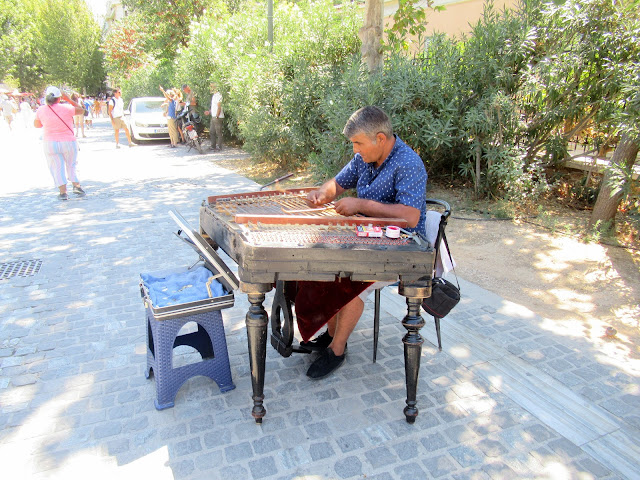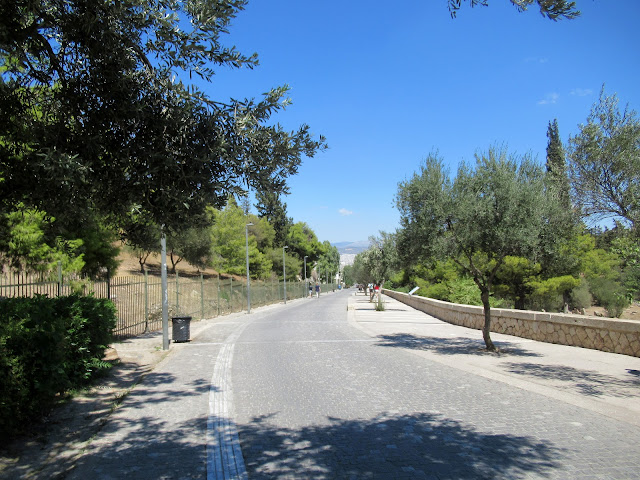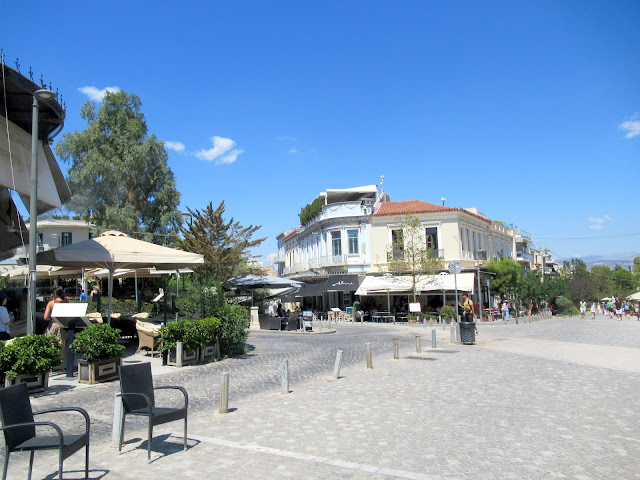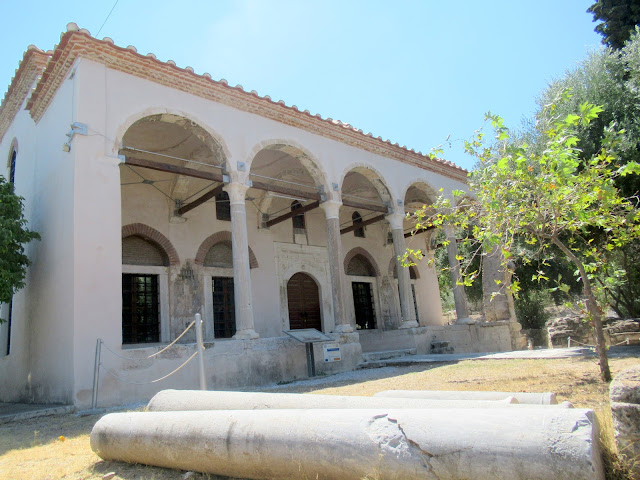We fancied a walk in Athens and some lunch. So we took the metro to the Acropolis stop
lots of ancient ceramics on display there
and some sculptures from the east pediment of the Parthenon.
We emerged outside the Acropolis museum by the cafeterias on the other side of the road
it was heaving.
We started walking along the Irodou tou Attikou avenue which is pedestrianised
there are always buskers here, but this time it was a guy playing beautifully an instrument I had not seen before. I asked him what it was and he said 'timbalo'. I have searched google and cannot find timbalo so maybe I misheard

The Acropolis on our right
and the entrance to the Acropolis museum on our left.
Next to the museum, one of my favourite buildings in Athens and one of the few Art Deco ones that are left
Some nice buildings along here
Much quieter now, less people, as we had moved away from the tourist sites
First sighting of the Herodus Atticus Roman amphitheatre - have seen so many plays and concerts here
and now a view of both the theatre and the Acropolis
opposite the theatre, a statue of Maria Callas as she performed here so often - even though I think that the theatre in Epidaurus was her preferred venue
the sculptor is by Aphrodite Lite
a curve on the road and it changes to Apostolou Paulou
there's lots of antiquities everywhere here
Through the opening in the rock, archaeologists found an underground chamber. On one of the walls was a relief chiselled on the bedrock, presenting Pan, a naked nymph and a dog. Archaeologists surmised that this was an unknown, not reported by any ancient writer, sanctuary of Pan. The cult of Pan in caves is apparently well documented.
We had now entered the district of Thiseio. The outdoor cinema
The Lycabettus hill in the distance
zooming in
The church of St Marina and next to it the National Observatory. If you look closely at the church you will see on its left, the original small chapel that was carved in the rock. Inside it was covered with numerous wall paintings. It is now a baptistery. The main church was built in 1924, a four-nave basilica with a massive dome, made in a Byzantine style.
We were now entering the area of the cafeterias
and moving towards Thiseio square
Adrianou Street which is full of restaurants, cafes and bars
stalls that sell jewellery and antiques
one of our favourite restaurants, Kuzina
empty because it was still too early
views of the Acropolis
a church
even though Kuzina was empty, the tourist restaurants were packed
We were now in the district of Plaka
I realised that I have never been inside this old Byzantine church which was converted into a mosque when the Turks occupied Greece for 400 years - this is something that needs to be remedied
 another view of the church, with ancient collumns all around it, as the ancient Agora is very near here
another view of the church, with ancient collumns all around it, as the ancient Agora is very near here
Aerides, the Tower of the Winds, one of my favourite ancient monuments, probably because it's one of the very small number of buildings from classical antiquity that still stands virtually intact. It's an octagonal Pentelic marble tower in the middle of the Roman Agora. It's got its name because of the eight large reliefs of wind gods around its top. Its date is uncertain but it was completed about 50 BC.
Some nice tavernas
before we got to the one we were heading for
the Old Fisherman's Tavern
We discovered this one last year. Even though it's in the middle of Plaka, an area where tourists flock because of the Acropolis, it's an old taverna, around 100 years old and it has retained its character and the quality of the food
We had an absolutely delicious lunch
and then moved on
lovely basil plants in their pots
and now we had entered the centre of the tourist area
the display of bottles in this bar is quite amazing
it's all bars, cafes and restaurants around here
and then it was time to get our bus back home.


































































Wow. Another great blogpost Eirene.
ReplyDeleteThe instrument was a "cimbalom".
https://www.youtube.com/watch?v=62x1HkiaWQA
That Byzantine church looks incredible. I have been reading a lot about Byzantine art (and watched Andrew graham-Dixon's documentary) and I was surprised to discover the conversion of The Hagia Sophia in Constantinople from Christianity to Islam. I would have assumed that both religions would have got rid of the old order and started afresh and build something "new" ... but, in fact, they re-used the old religious buildings. Having said that, most (if not all) of what we regard as Christian cathedrals and architecture derives from the commensurate pagan beliefs. What - in anything - can be said to be truly original?
I have to visit the Acropolis some day soon.
Thanks, and thanks for the cimbalom.
DeleteIt's true, churches and mosques kept being converted back and forth. It's one of religious Greeks' greatest sorrow that Agia Sofia was converted into a mosque. That is something they can't get over.